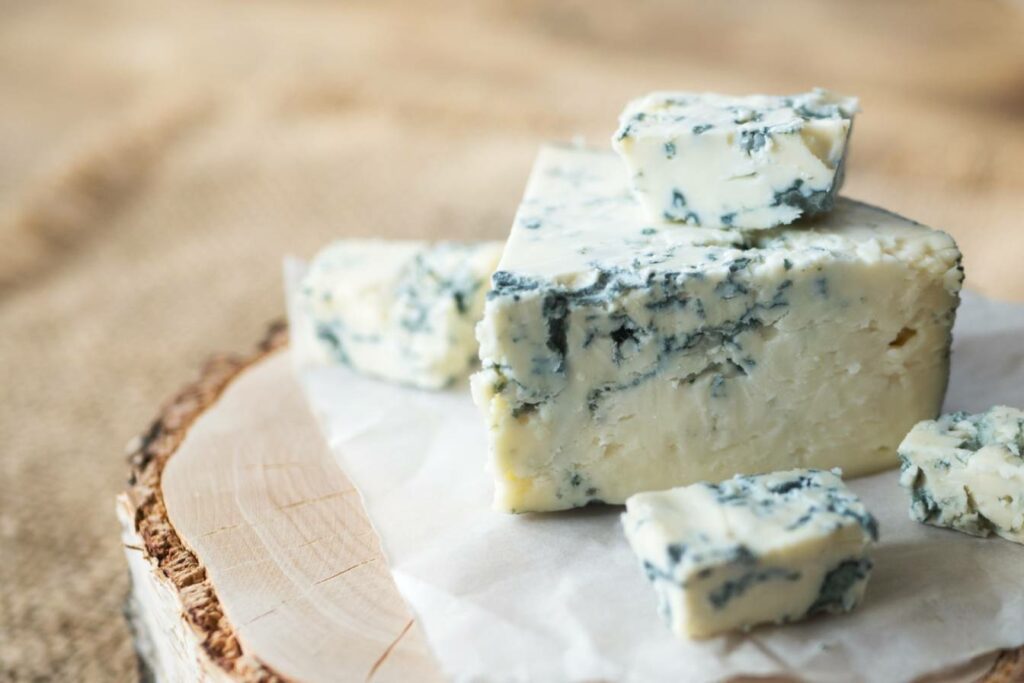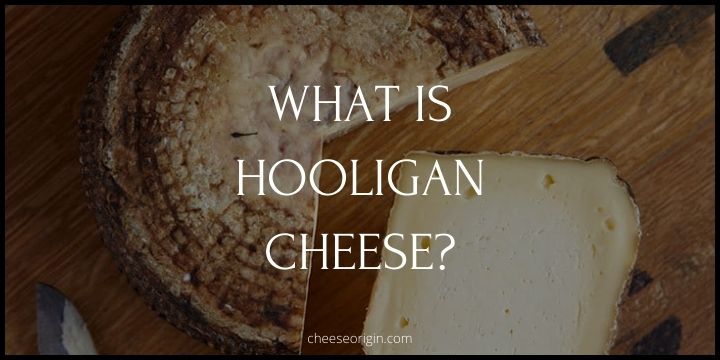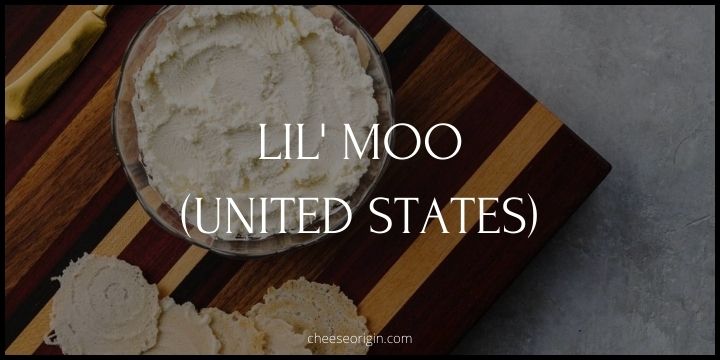What is Bleu du Vercors-Sassenage? A Monastic Legacy in Cheesemaking

Welcome to a culinary journey that will take us to the heart of the French Alps, where the air is crisp, the pastures are lush, and an ancient monastic legacy in cheesemaking thrives.
Today, we’re delving into the fascinating world of Bleu du Vercors-Sassenage. This blue-veined marvel, with its creamy texture and mild, nutty flavor, is more than just a cheese—it’s a testament to centuries-old traditions, a symbol of regional pride, and a mouthwatering delight that captivates cheese lovers across the globe.
So, tighten your seatbelts as we embark on this delectable adventure, exploring the history, the process, and the unique characteristics that make Bleu du Vercors-Sassenage a standout in the crowded landscape of French cheeses.
Quick Facts About Bleu du Vercors-Sassenage
| Country of Origin | France |
| Region | Rhône-Alpes, specifically Vercors Regional Natural Park |
| Age | 2 to 3 months (minimum 3 weeks) |
| AOC | 1998 |
| Classification | Blue, Semi-soft |
| Milk | Cow |
| Weight and shape | 5 to 6 kg (11 lb to 13 lb 4 oz), Wheel |
| Fat content | 48% |
| Size | Diameter 15 cm (12 inches), Height 7.5 cm (3 inches) |
| Aroma | Nutty, Milky, Intense, Earthy |
| Taste | Mild, sweet, and nutty with a hint of mushrooms |
| Pairing | Aperitifs, Cahors, Sauternes, Quiches, Soufflés, Walnut bread |
| Texture | Soft, supple, creamy, crumbly |
| Color | White-browny rind; pale yellow paste |
| Production | Year-round, but the best quality is produced from spring to autumn |
What is Bleu du Vercors-Sassenage?

Bleu du Vercors-Sassenage is a fascinating blue cheese steeped in history, originating from the Rhône-Alpes region of France. A testament to centuries-old traditions, this cheese was first produced by monks and has since become a cherished part of France’s culinary heritage.
The cheese is known for its mild flavor profile, a characteristic that distinguishes it from other, more pungent blue cheeses. It boasts an ivory-colored paste that is relatively dense, a feature that can be attributed to the mix of warm, raw fresh milk and the previous evening’s cow’s milk used in its production.
This cheese is not just about taste; it’s also a feast for the eyes. The rind of Bleu du Vercors-Sassenage is characterized by a thin whitish-gray down that can have pinkish-orange spots, adding to its visual appeal. The cheese itself is presented as a wheel weighing between 4 to 4.5 kg, with a fine, white to grey-blue mold-type bloom that may have orange to ivory hues.
Historically, Bleu du Vercors-Sassenage holds a unique place. In the 14th century, citizens were told to pay their taxes in cheeses, giving this dairy product a significant role in the economy of the time. Today, it is a Protected Designation of Origin (PDO) product, a status that attests to its quality and authenticity.
Produced using milk from three breeds of cow – Abondance, Montbéliarde, and Villard de Lans – this cheese has also played a part in animal conservation. Specifically, its production has helped rehabilitate the Villard’s cow that almost disappeared during the 70s.
In essence, Bleu du Vercors-Sassenage is more than just a cheese. It is a piece of history, a symbol of tradition, and a reflection of the rich biodiversity of the Rhône-Alpes region. Enjoying it is not just a culinary experience, but also a journey into France’s vibrant past and its enduring love for quality and authenticity in food.
What Does Bleu du Vercors-Sassenage Taste Like?
Bleu du Vercors-Sassenage is known for its mild and delicate flavor, which sets it apart from many other blue cheeses that are often strong and pungent. It has a creamy, buttery texture that melts in your mouth, and the taste is a harmonious blend of sweet, nutty, and earthy flavors.
Upon the first bite, you’ll notice a sweet, milky taste, reminiscent of fresh cream. This then gives way to subtle hints of nuts and mushrooms, adding depth and complexity to the flavor profile. Despite being a blue cheese, there is only a faint hint of the characteristic blue cheese sharpness, making it more approachable for those who are new to blue cheese.
The cheese also has a unique aftertaste. The lingering flavor is mildly tangy and salty, which perfectly complements its initial sweetness. The mold in the cheese imparts a slight earthiness, rounding off the taste experience.
Pair this cheese with a sweet wine like Sauternes or Port, and you’ll further enhance its unique flavor characteristics. Fruits like pears and apples also make excellent accompaniments, as their fresh, crisp flavors contrast beautifully with the rich creaminess of the cheese.
In essence, Bleu du Vercors-Sassenage offers a gentle and balanced flavor journey, making it a delightful addition to any cheese board.
Bleu du Vercors-Sassenage Tasting Notes

- Mild and Delicate: Bleu du Vercors-Sassenage is a mild blue cheese, which makes it more approachable to those who are new to this category of cheeses.
- Creamy and Buttery: The texture of this cheese is creamy and buttery, offering a delightful mouthfeel that melts in your mouth.
- Sweet Initial Flavor: Upon first taste, the cheese has a sweet, milky flavor reminiscent of fresh cream.
- Nutty Undertones: There are subtle hints of nuts that add depth and complexity to the overall flavor profile.
- Earthy Mushroom Notes: A hint of earthy mushrooms can be detected, further enhancing the complexity of its flavor.
- Faint Sharpness: Despite being a blue cheese, the sharpness typically associated with this type of cheese is only faintly present, adding a slight tanginess.
- Salty Aftertaste: The lingering aftertaste is mildly salty, perfectly complementing the initial sweetness of the cheese.
- Pairing Recommendations: Bleu du Vercors-Sassenage pairs well with sweet wines like Sauternes or Port. Fruits like pears and apples also make excellent accompaniments, offering a fresh contrast to the rich creaminess of the cheese.
What Pairs Well With Bleu du Vercors-Sassenage
Food that goes well with Bleu du Vercors-Sassenage:
| Category | Food Pairing |
|---|---|
| Fruits | Pears, Apples, Figs, Grapes |
| Breads and Crackers | Baguette, Walnut Bread, Multigrain Crackers |
| Meats | Prosciutto, Salami, Roast Beef |
| Nuts and Seeds | Walnuts, Almonds, Sunflower Seeds |
| Jams and Spreads | Fig Jam, Pear Preserves, Honey |
| Vegetables | Celery Sticks, Cherry Tomatoes, Bell Peppers |
| Sweets | Dark Chocolate, Dates, Dried Apricots |
Also read: What Fruit Goes on a Charcuterie Board?
Beverage that goes well with Bleu du Vercors-Sassenage:
| Category | Beverage Pairing |
|---|---|
| Wine | Sauternes, Port, Riesling, Beaujolais, Chatillon en Diois (light and fruity), Cahors |
| Beer | Belgian Tripel, IPA (India Pale Ale), Brown Ales |
| Spirits | Brandy, Whiskey, Armagnac |
| Non-Alcoholic | Sparkling Water, Apple Cider, Grape Juice |
Also read: Best Wine and Cheese Pairings: The Ultimate Guide

The Intriguing History and Origin of Bleu du Vercors-Sassenage: A Taste of Tradition
Bleu du Vercors-Sassenage, a blue-veined cheese with a rich history, hails from the verdant Vercors region of France. This cheese’s story is as intriguing as its flavor, and it all begins in the 14th century.
A Cheese Born Out of Tradition
In the Middle Ages, monks in the Rhône-Alpes region started producing this mild, pasteurized, natural rind cow’s milk blue cheese. The cheese was known as ‘fromage de Sassenage,’ named after the town of Sassenage. Interestingly, citizens were told to pay their taxes in cheeses, indicating the high value placed on this dairy product even back then.
Evolution Over Time
Over centuries, the traditional cheese-making methods passed down from generation to generation have remained largely unchanged. The cheese’s production was mostly limited to the Vercors Plateau, where the specific conditions of the region played a significant role in shaping the cheese’s distinctive characteristics.
The Vercors region’s lush pastures provide an excellent diet for the cows, contributing to the rich, creamy milk used in cheese production. This regional influence is integral to the cheese’s unique flavor profile, which features a mild and creamy taste with a hint of hazelnut.
Iconic French Cheese
Bleu du Vercors-Sassenage has evolved into an iconic French cheese, recognized and protected under the Appellation d’Origine Contrôlée (AOC) label. This certification ensures that the cheese is produced following specific standards, including being made in the designated geographical area using traditional methods.
Cultural Significance and Impact
The cultural impact of Bleu du Vercors-Sassenage extends beyond the realm of gastronomy. It is not merely a cheese; it is a symbol of the region’s heritage and tradition. The cheese-making process is deeply ingrained in the community’s lifestyle and has played a significant role in shaping the local economy.
The cheese’s popularity has also influenced the local culinary scene. Its distinctive flavor and texture have made it a staple ingredient in many regional dishes, further cementing its cultural significance.
Anecdotes and Legends
One compelling anecdote associated with this cheese is its historical use as a form of tax payment. This unusual practice underscores the immense value attached to the cheese and the integral role it has played in the region’s socio-economic fabric.
In conclusion, the history and origin of Bleu du Vercors-Sassenage are as captivating as the cheese itself. It stands as a testament to time-honored traditions, regional influences, and the enduring allure of good food. This cheese is not just a delight for the taste buds; it’s a slice of French history.
Where to Buy Bleu du Vercors-Sassenage:
- Food Origin – 200 g for $74
- Lemarche.co.nz – 100 g for $9
More Cheeses from France:







